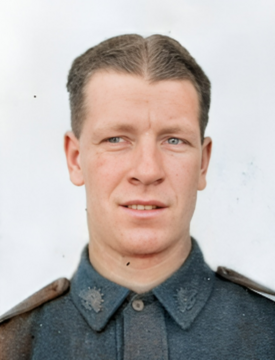
BRITTEN, George William
| Service Number: | VX21868 |
|---|---|
| Enlisted: | 18 June 1940 |
| Last Rank: | Private |
| Last Unit: | 2nd/22nd Infantry Battalion |
| Born: | Horsham, Victoria, Australia, 22 April 1918 |
| Home Town: | Horsham, Wimmera, Victoria |
| Schooling: | Not yet discovered |
| Occupation: | Labourer |
| Died: | Executed whilst a prisoner of the Japanese, Rabaul, New Britain, Bismarck Archipelago, New Guinea, 4 February 1942, aged 23 years |
| Cemetery: |
Rabaul (Bita Paka) War Cemetery, Papua New Guinea (CWGC) Burial Reference ~ Plot A, Row C, Grave 3. Personal Inscription ~ "DIED DOING HIS DUTY FOR HIS COUNTRY AND LOVED ONES...ALWAYS REMEMBERED". |
| Memorials: | Australian War Memorial Roll of Honour, Ballarat Australian Ex-Prisoners of War Memorial |
World War 2 Service
| 3 Sep 1939: | Involvement Private, VX21868 | |
|---|---|---|
| 18 Jun 1940: | Enlisted Australian Military Forces (WW2) , Private, VX21868, 2nd/22nd Infantry Battalion | |
| 4 Feb 1942: | Wounded Australian Military Forces (WW2) , Private, VX21868, 2nd/22nd Infantry Battalion, Executed by Japanese - Private George William Britten was one of approximately 160 Australian soldiers massacred by the Japanese in separate incidents at the Tol Plantation in New Britain on 4 February 1942 |
Help us honour George William Britten's service by contributing information, stories, and images so that they can be preserved for future generations.
Add my storyBiography contributed by Ant McLean
VX21868 Private George William Britten enlisted in the Army on 18 June 1940 and was allocated to Australian Army Service Corp (A.A.S.C.).
On 2 July 1940 Private Britten commenced a cooking course at Bendigo, Victoria.
29 July 1940 Private Brittain was posted to the newly raised 2nd/22nd Infantry Battalion, part of the 23rd Brigade of the 8th Division.
The Battalion was initially headquartered at Victoria Barracks in Melbourne, but on 11 July moved to Trawool in central Victoria for training.
On 24 September the 2/22nd began to move to Bonegilla, near Wodonga on the New South Wales - Victoria border.
The battalion made the 235 km journey on foot and arrived on 4 October. Training soon resumed, occupying the battalion until it entrained for Sydney, ultimately bound for New Britain on 17 April 1941.
The 2/22nd Battalion arrived in Rabaul, the administrative centre of New Britain on 26 April 1941. It combined with local unit of the New Guinea Volunteer Rifles, a coastal defence battery, an anti - aircraft battery, and elements of the 2/10th Field Ambulance and 17th Anti - tank Battery to form Lark Force.
The force would later be supported by 24 Squadron, Royal Australian Air Force (RAAF).
Lark Force was ill - equipped and likely to be overwhelmed by enemy attack. Nonetheless, the 2/22nd spent the next months constructing defences and training for operation in a tropical environment.
Japanese bombing of New Britain began in early January 1942, increasing in intensity as the month continued. By the morning of 22 January, 24 Squadron was virtually destroyed and its three remaining aircraft were withdrawn.
By the 23 January the Japanese had a strength of 5,000 troops compared to the 1,400 of Lark Force, subsequently, the Lark Force Commander, Colonel John Scanlon ordered a withdrawal, on the basis of "every man for himself". Unprepared for retreat, chaos ensued and Lark Force disintergrated.
In the ensuing days 2/22nd parties, ranging from company - strength down to pairs and individuals, sought escape along New Britain's north and south coast. Some found small boats and got away under their own auspices; others were picked up by larger vessels operating from New Guinea. Around 400 members of Lark Force managed to return to Australia, 300 of which were members of the 2/22nd.
Unfortunately, Private William George Britten, 2/22 Australian Infantry Battalion was one of approximately 160 Australian Soldiers, to be captured by the Japanese, and became POW's, only then to be massacred by the Japanese in a series of separate incidents at the Tol Plantation in New Britain on 4 February 1942.
After crossing the Bainings Mountains many men decided to head towards Tol and Waitavalo, while others continued heading south.
On 3 February 1942, the Japanese attacked Tol, capturing a number of men as they tried to escape from the plantation. Others were captured when they were unable to cross the rivers in the area around Henry Reid Bay and at least one group surrendered.
The men, now Prisoners of War (POWs) were forced to surrender all of their personal belongings and were tied together in groups of two or three.
They were asked in sign language by the Japanese if they preferred to be shot or bayoneted.
The groups were then taken into the jungle where they were shot, bayoneted, or burnt alive.
Six men survived the massacre and with the help of local natives were able to make contact with the 150 others from Rabaul who had evaded the Japanese and gathered around Palmalmal Plantation. This group was evacuated from Palmalmal Plantation on 12 April 1942 on HMAS Laurabada.
Private Britten, aged 23, was the son of Charles Richard Britten of Ballarat, Victoria, Australia.
Courtesey: Australian War Memorial














